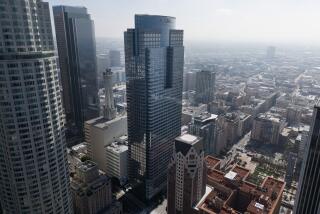Cities Urged to Update Skyscraper Fire Codes
NEW YORK — A federal engineering agency that investigated the World Trade Center collapse recommended Thursday that cities raise the fire standards for skyscrapers and develop new materials that could better protect tall buildings in an inferno.
Engineers with the National Institute of Standards and Technology said, for example, that stairwells should be situated apart from each other so that if one is damaged another might still work. They also urged installation of “fire-protected and structurally hardened elevators” designed to function in a blaze.
“Such elevators should be installed for exclusive use by emergency responders during emergencies,” the institute said in its draft recommendations on the twin tower collapse.
The institute does not have the authority to alter building codes but hopes to persuade local authorities to make the changes.
“We believe that the recommendations are realistic and achievable,” said Shyam Sunder, the lead institute investigator. He said the costs would vary, but he did not take issue with reports suggesting that for most new buildings, construction expenses would rise 2% to 5%.
The institute’s three-year investigation gathered reams of data on such things as fire tests on steel and office workers’ evacuation behavior to determine exactly how the 110-story towers fell after two hijacked jetliners slammed into them on Sept. 11, 2001. A total of 2,749 people were killed.
The analysis does not blame the collapse on the steel or design of the towers. The institute’s engineers concluded the towers probably would have remained standing if the impact of the airplanes had not stripped away fireproofing material on steel columns.
Without that fireproofing, fires continued to burn inside offices, weakening the building’s skeleton until it collapsed under its own weight.
The institute’s report calls for the development of more durable fire-resistant materials and technologies.
The investigation considered a number of what-if scenarios, some hopeful, some terrifying.
The institute determined that if the twin towers had been struck later in the day at full occupancy, 14,000 people could have died. On the other hand, if the buildings’ elevators had been better protected, more people would have escaped.
The agency’s report also examined emergency response efforts after the attack. It concluded that some of the victims might have been saved with stronger evacuation systems and better communication among rescuers.
Emergency workers need to change how they coordinate rescue efforts, the investigators concluded. The report recommended that much of the intelligence-gathering and decision-making be overseen from outside the building. It also suggested keeping a “black box” to record critical information for study after a major incident.
More to Read
Sign up for Essential California
The most important California stories and recommendations in your inbox every morning.
You may occasionally receive promotional content from the Los Angeles Times.










